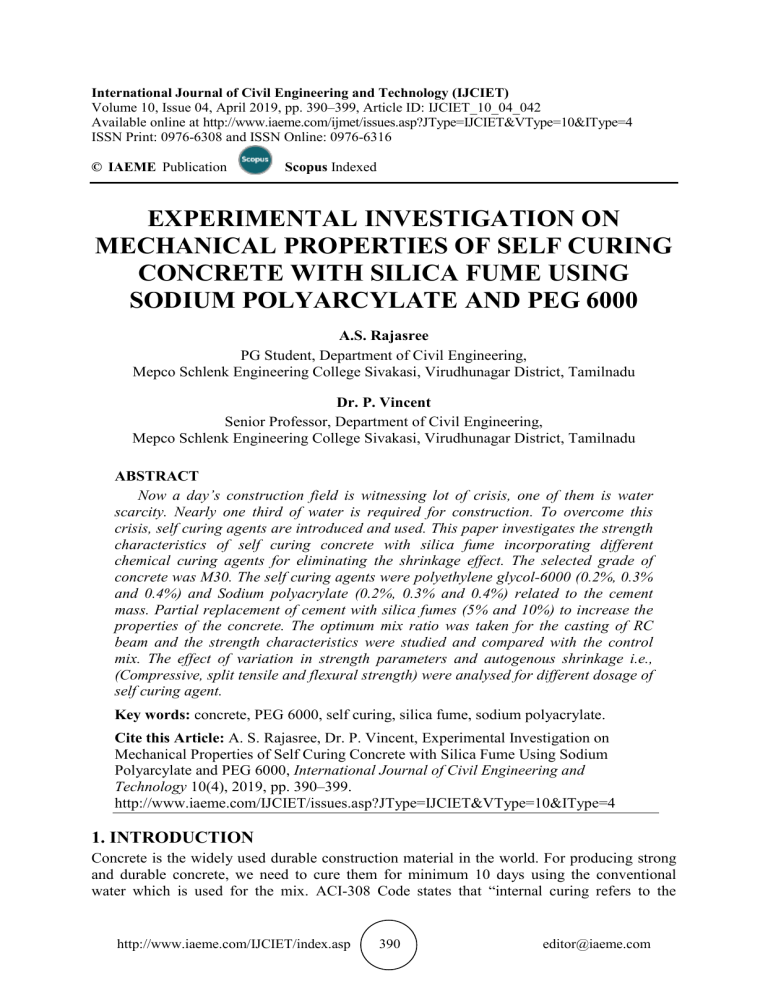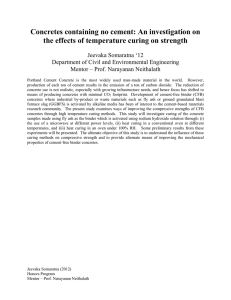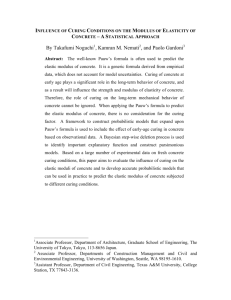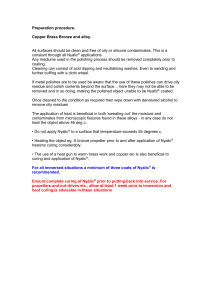EXPERIMENTAL INVESTIGATION ON MECHANICAL PROPERTIES OF SELF CURING CONCRETE WITH SILICA FUME USING SODIUM POLYARCYLATE AND PEG 6000
advertisement

International Journal of Civil Engineering and Technology (IJCIET) Volume 10, Issue 04, April 2019, pp. 390–399, Article ID: IJCIET_10_04_042 Available online at http://www.iaeme.com/ijmet/issues.asp?JType=IJCIET&VType=10&IType=4 ISSN Print: 0976-6308 and ISSN Online: 0976-6316 © IAEME Publication Scopus Indexed EXPERIMENTAL INVESTIGATION ON MECHANICAL PROPERTIES OF SELF CURING CONCRETE WITH SILICA FUME USING SODIUM POLYARCYLATE AND PEG 6000 A.S. Rajasree PG Student, Department of Civil Engineering, Mepco Schlenk Engineering College Sivakasi, Virudhunagar District, Tamilnadu Dr. P. Vincent Senior Professor, Department of Civil Engineering, Mepco Schlenk Engineering College Sivakasi, Virudhunagar District, Tamilnadu ABSTRACT Now a day’s construction field is witnessing lot of crisis, one of them is water scarcity. Nearly one third of water is required for construction. To overcome this crisis, self curing agents are introduced and used. This paper investigates the strength characteristics of self curing concrete with silica fume incorporating different chemical curing agents for eliminating the shrinkage effect. The selected grade of concrete was M30. The self curing agents were polyethylene glycol-6000 (0.2%, 0.3% and 0.4%) and Sodium polyacrylate (0.2%, 0.3% and 0.4%) related to the cement mass. Partial replacement of cement with silica fumes (5% and 10%) to increase the properties of the concrete. The optimum mix ratio was taken for the casting of RC beam and the strength characteristics were studied and compared with the control mix. The effect of variation in strength parameters and autogenous shrinkage i.e., (Compressive, split tensile and flexural strength) were analysed for different dosage of self curing agent. Key words: concrete, PEG 6000, self curing, silica fume, sodium polyacrylate. Cite this Article: A. S. Rajasree, Dr. P. Vincent, Experimental Investigation on Mechanical Properties of Self Curing Concrete with Silica Fume Using Sodium Polyarcylate and PEG 6000, International Journal of Civil Engineering and Technology 10(4), 2019, pp. 390–399. http://www.iaeme.com/IJCIET/issues.asp?JType=IJCIET&VType=10&IType=4 1. INTRODUCTION Concrete is the widely used durable construction material in the world. For producing strong and durable concrete, we need to cure them for minimum 10 days using the conventional water which is used for the mix. ACI-308 Code states that “internal curing refers to the http://www.iaeme.com/IJCIET/index.asp 390 editor@iaeme.com Experimental Investigation on Mechanical Properties of Self Curing Concrete with Silica Fume Using Sodium Polyarcylate and PEG 6000 process by which the hydration of cement occurs because of the availability of additional internal water that is not part of the mixing Water”[1].To minimize the amount of water used for the construction, self curing is adopted. There are diverse internal curing agents procurable in market such as water paper shred, saw dust, calatropis gigantean milkweed, palak green leaves, super absorbent polymer (SAP), PEG Poly ethylene glycol etc., Poly ethylene glycol 6000 and sodium polyacrylate is chosen as an internal curing agent because of its low priced and easy availability.PEG 6000 and sodium polyacrylate is added to the concrete with respect to the percentage of cement added to it. Optimum percentage of PEG 6000 can be found out by the trial and error method of addition. Pericles savva et al [2] reports that self desiccation occurs due to two factors, scarcity of water in curing and reduction of disjoining pressure. Internal curing acts as a water body for calcium silicate hydrate gel(C-S-H) formation. A.S. Ei-dieb [3] says that during internal curing process no evaporation takes place, which increases hydration process. Water retention will be high compared to conventional concrete. Curing of concrete plays a major role in concrete microstructure. M.M.Kamal et al [4] shows that efficient curing increases the strength and durability of the concrete. The experimental study undergoes internal curing of self compacting concrete. There are several material used for internal curing such as light weight aggregate (LWA), lightweight natural sand (LWS), wood powder, SAP and shrinkage reducing agents etc., Polyethylene glycol product has been recently used as self curing agent to reduce the crack ,drying and shrinkage because of the continuous supply of water to concrete. PEG400 and PEG600 as 1%, 2%, 3%, 4% and 5% of cement relative mass was used as self curing agent for RC beam. By using PEG 400 RC beam and conventional beam behaves robust and number of cracks can be diminished when comparing to PEG 600.There is no self desiccation in self curing concrete. Kaustav sarkar et al [5] this paper focus on the feasibility of using SAP and PEG 6000 used for cement replacement in mortar, water to cement ratio of 0.4 and above. The traditional method for curing is ponding, spraying and wet jute bag cover. Self curing method can be used to eradicate the water demand problem even if there is water scarcity in future generation. The minimum and maximum level of temperature is noted for higher dosage of SAP and PEG 6000 to escalate the hydration process and gives early strength to the concrete. David.O.Nduka et al [6] focus on awareness and benefits of self curing concrete in Civil Engineering perceptions. It decreases the coefficient of thermal expansion, tensile creep and shrinkage. It improves the interfacial transition zone (ITZ) and high degree of hydration. Magda.I.Mousa et al [7] reports that physical properties of self curing agent. Pre soaked lightweight aggregate, (0% to 20%) volume of sand and Ch (1% to 3% weight of cement used as self curing agent. (0% to 15%) of silica fumes were used as replacement of relative cement mass. 2% of Ch gives better result compared to conventional concrete and addition of silica fume increases the pozzolanic reaction and decreases the voids. Magda.I.Mousa et al [8] shows that incorporation of silica fume increases concrete strength in addition with 2% of polyethylene glycol that achieves good durability under self curing regime. 2. RESEARCH SIGNIFICANE Self curing concrete is made using PEG-6000 and sodium polyacrylate, so that the cost of construction is reduced by minimizing the amount of water used for construction. Autogenous shrinkage is diminished by using an internal curing agent; it act as a reservoir for the concrete curing, it supplies water to the concrete for hydration reaction from inside. Internal curing agent is also used to minimize the early age cracking in concrete by supplying water regularly for hydration of concrete. The aim of the experimental program is to compare the efficiency of self curing concrete with silica fume using chemical agents. For this study, things to be determine are, optimum percentages of PEG-6000, flexural behavior of self curing concrete http://www.iaeme.com/IJCIET/index.asp 391 editor@iaeme.com A. S. Rajasree, Dr. P. Vincent and mechanical properties of self curing concrete. The momentous of this project is to provide sufficient data for the researcher and engineers for concerning the usage of PEG 6000 in the water scarcity area, where the concrete curing process are difficult. PEG 6000 is a water soluble polymer which resists corrosion and increases the durability of the concrete. 3. MATERIAL USED 3.1. Cement The Ordinary Portland Cement 53 grade ultratech cement confirming to IS 12269-1987 [9] was used throughout this project. The specific gravity of cement is 3.154. 3.2. Fine Aggregate Locally available Natural River sand of size below 4.75 mm conforming to Zone II of IS 3831970 is used as fine aggregate [10].Specific gravity of fine aggregate is 2.62 3.3. Coarse Aggregate Coarse aggregate used in this study consist of size 20 mm. Laboratory tests were conducted on coarse aggregate to determine the different physical properties as per IS: 383-1970 [10]. Specific gravity of coarse aggregate is 2.67. 3.4. Reinforcement High Yield Strength Deformed bars are used for the RC beam.12 mm bars were used as longitudinal reinforcement and 8 mm bars were used for lateral ties [11]. 3.5. Silica Fume Silica fume (very non crystalline silicon dioxide) is a byproduct of the manufacture of silicon, ferrosilicon etc., According to IS: 456 [11] silica fume is usually used in proportion of 5% to 10% of the cement content of a mix. In this study commercially available silica fume is used (Enfiq Civil Innovative Chemicals & Systems,Tirunelveli). Specific gravity of silica fume is 2.2. XRF result from CECRI karaikudi, result shows silica content is more about 90.298 so it is suitable for concrete which is shown in the figure 1. Figure 1 XRF result for silica fume http://www.iaeme.com/IJCIET/index.asp 392 editor@iaeme.com Experimental Investigation on Mechanical Properties of Self Curing Concrete with Silica Fume Using Sodium Polyarcylate and PEG 6000 3.6. Polyethylene Glycol 6000 Shrinkage reducing agent poly ethylene glycol 6000 is used as self curing agent which may commercially procurable like granules (Sairam scientific, Madurai). PEG 6000 is further synthesised to liquid state by melting at 650c.To determine the water retaining capacity for PEG 6000 water absorption test is done and the details are given in the table 1. Table 1 Water Absorption for PEG 6000 Dry weight Saturated weight Water absorption (gms) (gms) S No Material 1 PEG 6000 25 1545 62 times 3.7. Sodium Polycrylate Super absorbent polymer is also called slush powder, which can absorb 100 to 300 times of its own weight and convert into hydro gel. In this study commercially procurable sodium polyacrylate is used (chemzest enterprises, Chennai) for self curing agent. This sodium polyacrylate SAP is used for internal curing purpose for concrete. Chemical Formula [−Ch2−ch(co2na)−]n Sodium polyacrylate (SP), also known as water lock SAP act as self curing agent in concrete. Sodium Polyacrylate crystallizes as white powder. It takes up water as much as 400 to 500 times its dry size and swells to form a polymeric gel. 85-50 mesh Particle Size 6.0-7.0 pH Value ≤5 % of moisture 3.7.1. Mechanism Sodium Polyacrylate polymer can retain large amount of water because of the osmotic pressure (i.e. movement of water through a semi permeable membrane). The osmotic pressure induced by high water content concentration outside a sodium polyacrylate molecule brought the water into center of the molecule. Sodium polyacrylate continuously absorb the water until there is an equal pressure of water inside and outside the sodium polyacrylate molecule. To determine the water retaining capacity for SAP water absorption test is done and details are given in the table 2. Table 2Water Absorption for SAP S No Material 1 SAP Dry weight Saturated weight (gms) (gms) 25 1875 Water absorption 75 times 4. EXPERIMENTAL WORK 4.1. Compressive Strength The most common of all tests on hardened concrete is the compressive strength test. Compressive strength test on specimen is treated in a standard manner which includes full compaction and curing for a specified period which gave results representing the potential quality of the concrete. The age at which specimen tested is governed by the information required. The standard specimen is tested at prescribed ages, generally 28 days, with http://www.iaeme.com/IJCIET/index.asp 393 editor@iaeme.com A. S. Rajasree, Dr. P. Vincent additional test often made at 3 to 7 days. The Dimension of cube mould is 150 mm x 150 mm x 150 mm. Compressive strength is done by various percentages of self curing agents and addition of 10% silica fume. The compressive strength test under UTM is shown in figure 2. The compressive strength results are shown in the table 3 and graph plotted for compressive strength is shown in the figure 3 and 4. Compressive strength in MPa = P / A Figure 2.Compressive strength of concrete test under UTM Table 3 Compressive Strength for 7 and 28 days Sample Conventional concrete Compressive strength N/mm2 7 days 28 days 26.18 33.56 Percentage Self curing 0.2 0.3 0.4 0.2 0.3 0.4 0.2 0.3 0.4 0.2 0.3 0.4 Sodium polyacrylate 5 % silica fume PEG 6000 Sodium polyacrylate 10% silica fume PEG 6000 18.85 23.39 23.21 19.21 22.93 23.30 26.23 27.12 25.62 27.38 25.83 25.87 28.76 32.13 31.52 29.15 30.67 32.07 34.15 34.65 33.74 36.45 33.94 34.07 Figure 3 Compressive Strength Comparison for 7 days test http://www.iaeme.com/IJCIET/index.asp 394 editor@iaeme.com Experimental Investigation on Mechanical Properties of Self Curing Concrete with Silica Fume Using Sodium Polyarcylate and PEG 6000 Figure 4 Compressive Strength Comparison for 28 days test 4.2. Split tensile strength test Split tensile strength is used to determine the tensile strength of the concrete indirectly. It is done by using a cylinder specimen of diameter 150 mm and height 300mm.The specimen is placed horizontally in the compression testing machine and loaded. The test is performed for 28 days is shown in table 3.2.While using 5 % of silica fume in self curing concrete didn’t show any increment in concrete’s strength were as 10 % silica fume showed an increase in strength of self curing concrete to a level of 0.2% PEG 6000 28 days strength 3.415 N/mm 2 compared to conventional concrete. The split tensile strength result is shown in table 4 and cylinder testing in UTM is shown in the figure 5 and graph is shown in the figure 6. Tensile strength = 2P/πDL Figure 5 Failure of cylinder under UTM Table 4 Split Tensile Strength for 28 days Sample Conventional concrete Sodium polyacrylate with silica fume 5% PEG 6000 with silica fume 5% http://www.iaeme.com/IJCIET/index.asp Percentage Self curing 0.2 0.3 0.4 0.2 0.3 0.4 395 Split tensile strength N/mm2 28 days 3.264 2.750 2.910 3.050 2.950 3.134 3.212 editor@iaeme.com A. S. Rajasree, Dr. P. Vincent 0.2 0.3 0.4 0.2 0.3 0.4 Sodium polyacrylate with silica fume 10% PEG 6000 with silica fume 10% 3.256 3.304 3.235 3.415 3.334 3.243 Figure 6 Split Tensile Strength for 28 days 4.3. Flexural strength After the curing period, the specimen is taken out from the curing tank and wiped clean. The dimension of the specimen and the weight of the specimen were noted down with accuracy. The beam testing machine should be provided with two rollers 38 mm diameter on which the specimen is placed and the rollers are spaced such that the distance between two rollers should be 333.34 mm. The load is applied through two similar rollers mounted at the third point of the supporting span, i.e., 333.34 mm centre to centre. The load is divided equally between the two point loading rollers which are mounted in such a manner that the load is applied axially and without subjecting to any torsion stresses. Flexural strength = PL/BD2 Length = 1200m mm, Breadth = 100 mm, Depth =150 mm, d = 120 mma = 333.33 mm. Provided 4 nos of 12 mm dia bar for main reinforcement and 8 mm dia for vertical stirrups spacing of 140 mm c/c Beam subjected to two point loading y = wa/24EI( 3L2 -4a2) EI = flexural rigidity L = length of the member W = load y = deflection (value obtained from graph) 4.3.1. Conventional Beam RC beam M30 grade concrete have a size of 1200 mm length, 100 mm breadth and 150 mm depth. Two point loading support is shown in fig 7 and result comparison shown in the table 5. http://www.iaeme.com/IJCIET/index.asp 396 editor@iaeme.com Experimental Investigation on Mechanical Properties of Self Curing Concrete with Silica Fume Using Sodium Polyarcylate and PEG 6000 Figure 7 Two Point Load testing for Conventional beam 4.3.2. Self Curing RC Beam using 10% Silica fume and 0.2% PEG 6000 Self curing RC beam M30 grade concrete using polyethylene glycol 6000 0.2% and silica fume 10% have a size of 1200 mm length, 100 mm breadth and 150 mm depth. Two point loading support is shown in the figure 8 and result comparison is shown in the table 5. Figure 8 Two point load beam testing for SC beam using PEG 6000. 4.3.3. Self Curing RC Beam using 10% Silica fume and 0.3% of sodium polyacrylate Self curing RC beam M30 grade concrete using sodium polyacrylate 0.3% and silica fume 10% have a size of 1200 mm length, 100 mm breadth and 150 mm depth. Two point loading support is shown in the figure 9and result comparison is shown in the table 5. Figure 9 Two point load beam testing for Self Curing beam using sodium polyacrylate. http://www.iaeme.com/IJCIET/index.asp 397 editor@iaeme.com A. S. Rajasree, Dr. P. Vincent (a) (b) (c) Figure 10 (a) load deflection curve for conventional beam (b) load deflection curve for self curing beam 10%SF and sodium polyacrylate (c) load deflection curve for self curing beam 10%SF and PEG 6000 Table 5 Result Comparison for Conventional and SC beam Initial Beam Specimen Crack load (Tonne) Conventional 4.5 Beam 10% SF and PEG 5 6000 10% SF and sodium 3.5 polyacrylate Ultimate load (Tonne) Maximum deflection (mm) Ultimate moment (kNm) Flexural strength N/mm2 Flexural rigidity Nmm2 8.48 5.34 28.26 44.36 4.96 x 1011 9.14 5.76 30.46 47.80 6.9 x 1011 7.21 6.01 23.57 38.45 3.79 x 1011 5. CONCLUSIONS Based on the above investigation following results have been drawn By using self curing agent PEG 6000, water usage for curing can be reduced which decreases the evaporation loss and contribute hydration process. It diminishes the crack formation and act as a water reservoir for concrete by adding 10% of silica fume which increases pozzolanic reaction. http://www.iaeme.com/IJCIET/index.asp 398 editor@iaeme.com Experimental Investigation on Mechanical Properties of Self Curing Concrete with Silica Fume Using Sodium Polyarcylate and PEG 6000 The finishing surface for conventional and self curing beam is almost same; there is smooth surface without any autogenous cracking. Ultimate load carrying capacity of self curing beam using (PEG 6000 0.2% and 10 % SF) increase 7.78% compare to conventional beam but also increases 8.61% compressive strength and increases 4.62% split tensile strength compare to conventional concrete. Internal curing agent SAP and PEG 6000 has 50 to 110 times water retention capacity from its own weight, its dosage escalate the degree of hydration process. Water scarcity crisis can be overcome in future by introducing and implementing the PEG 6000 with concrete and diminishes the additional cost for water in scarcity area by using self curing agent. REFERENCES [1] [1] American Concrete Institute 2008 ACI 308R-01: “Guide to curing concrete. American Concrete Institute”, Farmington Hills”, MI, USA. [2] [2] Pericles savva, Michael F. Pertrou,“Highly absorptive normal weight aggregate for internal curing of concrete”, Construction and building materials 179, 2018, 80-88. [3] [3] A.S EI-Dieb, “Self curing concrete: water retention, hydration and moisture transport”,Construction and building materials 21, 2007, 1282-1287. [4] [4] M.M. Kamal, M.A Saffan, A.A Bhansandy, A.M. Kahil, “Experimental investigation on the behavior of normal strength and high strength self-curing self-compacting concrete”, Journal of Building Engineering 16, 2017,79-93. [5] [5] Kaustav sarkar, Bishwajit bhattacharjee, “Application of sap and PEG as curing agents for ordinary cement based systems: impact on the early age properties of paste and mortar with water-to-cement ratio of 0.4 and above”, European journal of environmental and civil engineering 2016. [6] [6] David O. Nduka, John O. Ameh Opeyemi johua and Rapheal Ojelabi, “Awareness and benefits of self curing concrete in construction”, Builders and civil engineering perceptions 2018. [7] [7] Magda I. Mousa, Mohamed G. Mahdy, Ahmed H, Abdel-Reheem, Akram Z. Yehia, “Physical properties of self-curing concrete (SCC)”, Housing and Building National Research Center 11, 2015, 167–175. [8] [8] Magda I. Mousa, Mohamed G. Mahdy, Ahmed H, Abdel-Reheem, Akram Z. Yehia, “Self-curing concrete types; water retention and durability”, Alexandria Engineering Journal 54, 2016,565–575. [9] [9] IS 12269:1987 - Indian standard for reaffirmed January 1999. [10] [10] IS 383:1970 - Specification from fine and coarse aggregate from natural source for concrete. [11] [11] IS456:2000 - Bureau of Indian Standard Plain and Reinforced Concrete, code of practice. http://www.iaeme.com/IJCIET/index.asp 399 specification for 53 grade OPC, editor@iaeme.com


